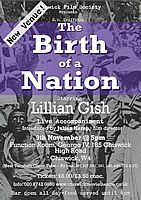Lawrence O'Connor of the Chiswick Film Society defends decision to screen racist movie
This Sunday Chiswick Film Society are screening the highly provocative The Birth of a Nation (1915, Dir D W Griffiths). It will be introduced by the britfilm director Julian Kemp & will have live accompaniment from local composer/pianist/violinist/teacher Mary O'Connor. The screening will begin at 5pm at the George IV, 185 Chiswick High Road W4 2DR.
Sign
up for our free weekly newsletter December Check the Society's web site for screening time. |
Not exactly
Gone with the Wind but not without similarities.. Chiswick Film Society
are about to screen a movie that depicts the evolving clansmen, wearing
their bed linen, as the great heroes of the United States (if not humanity
itself) and white actors in boot polish makeup portraying a shifty african-american
population who are unable to be grateful for being downtrodden and oppressed
by their white-skinned masters.
Historian Thomas Cripps has characterized The Birth of a Nation as “at
once a major stride for cinema and a sacrifice of black humanity to the
cause of racism.”
However W.D. Griffiths's The Birth of a Nation is not only beautifully
crafted it is highly significant as first hand historical testimony to
the culture of the time and of cinema as art form.
*Four key scenes from A Birth of a Nation convey the film’s powerful artistry,
historical distortions, and racist sensibilities:
1. A series of intertitles (text on the screen), drawn from A History
of the American People, published originally in 1902 by Woodrow Wilson,
who in 1915 just happened to be president of the United States; Wilson’s
prose introduces the Reconstruction section of the film, making the rise
of the Ku Klux Klan a positive good that resulted in the redemption of
the white South from the ravages of Negro and Carpetbagger rule.
2. A scene set in the South Carolina legislature in the early 1870s (introduced
with an intertitle that suggests that what is to follow is drawn from
“historic incidents”), which depicts newly elected black legislators lolling
in their chairs, their feet bare, eating chicken and drinking whiskey,
leering at white women in the visitors’ gallery.
3. A scene in which one of the film’s white southern heroes witnesses
a group of white children donning white bed sheets, inadvertently scaring
several black children playing nearby, which provides him with “The Inspiration”
for the Klan’s infamous outfits.
4. A scene of Klansmen, dressed in white sheets and astride horses, dumping
the body of the character Gus, an African American who they had killed
for causing Flora, the little sister of the story’s southern white protagonists,
to hurl herself off a cliff.
Rather than deny the existence of this work we think that it is not only
important to confront it as one would with any difficult work of art but
also that it is going to stimulate thought and dialogue and, in so doing,
create an opportunity for better understanding.
The movies shown so far as part of The Silent Season 2003, in many differing ways, have turned out to be a journey of significance for the majority of the Society's patrons & members and this will be no less true of this Sunday's experience of The Birth of a Nation. Why not come along and see for yourself...?
Lawrence O'Connor
November 5, 2003
